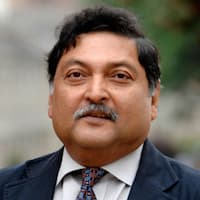Sugata Mitra Biography
Sugata Mitra is a computer scientist and educational theorist from India. He is best known for his “Hole in the Wall” experiment, which has been widely cited in literacy and education works.
How old is Sugata Mitra? – Age
He is 69 years old as of 12 February 2021. He was born in 1952 in Calcutta, West Bengal, India.
Sugata Mitra Family – Wife
He is married to Sushmita Mitra. He has an aunt named Paramita Biswas.
Sugata Mitra Education
After receiving a Ph.D. in Solid State Physics from the Indian Institute of Technology (IIT), Delhi, and publishing several papers on organic semiconductors during that time, he went on to study battery technology at the IIT’s Centre for Energy Studies, and later at the Technische Universität, Vienna. He published a paper on a zinc-chlorine battery as well as a speculative paper on why the human sense organs are arranged in the way they are.
He later worked on a networked computer setup and founded the “Yellow Pages” industry in India and Bangladesh. Mitra is an outspoken supporter of minimally invasive education. He holds a Ph.D. in physics but is credited with over 25 inventions in cognitive science and educational technology. In 2005, he received the Dewang Mehta Award for Innovation in Information Technology. Mitra received the Leonardo European Corporate Learning Award in the “Crossing Border” category in September 2012.
Sugata Mitra Net Worth
He has an estimated net worth of $9 million.
Sugata Mitra TED Talk
Mitra’s TED Talk “Build a School in the Cloud” was featured on NPR’s TED Radio hour on “Unstoppable Learning” on May 3, 2013. Mitra discusses the “Hole in the Wall” experiment in the program. Mitra claimed that children in India’s rural slums, many of whom had never seen a computer before, taught themselves everything from “character mapping” to advanced topics such as “DNA replication” on their own, without adult assistance, when given computers in kiosks. He proposed that this would result in “unstoppable learning” via a “global cloud,” in which children would pool their knowledge and resources in the absence of adult supervision to create a world of self-promoted learning. In 2013, he was awarded the TED Prize.
Sugata Mitra Hole in the Wall
The first Hole in the Wall (HIW) experiments in children’s learning were carried out in 1999. This study demonstrated that groups of children can learn to use computers and the Internet on their own by using public computers in public places such as roads and playgrounds. Vikas Swarup, an Indian diplomat, was inspired by HIW to write his debut novel Q & A, which was later adapted into the film Slumdog Millionaire.

What did Mitra find from his experiment?
Mitra discovered through his experiments that children in groups could easily navigate and learn from the internet. He also discovered that children learned more and faster in groups while using the computer.
Sugata Mitra Career
Mitra’s work at NIIT resulted in the creation of the organization’s first curricula and pedagogy, which was followed by years of research on learning styles, learning devices, several of which are now patented, multimedia, and new methods of learning. Professor Mitra’s publications and work have resulted in the training and development of perhaps a million young Indians, including some of the world’s poorest children, since the 1970s. Some of this work resulted in a fascination with early literacy and the Hole in the Wall experiments.
Some have questioned whether leaving computers in villages leads to improvements in math and other skills. Michael Trucano discovered no evidence of increases in these key skills in a study in Peru that bore some resemblance to Sugata Mitra’s studies but had many differences. Others see the idea as a rehash of what they see as a “dump hardware in schools and hope for magic to happen” strategy.
The kiosk system’s long-term viability has been called into question because it is prone to disrepair and abandonment unless school-like resources are provided. Donald Clark, a UK education researcher, has gathered significant support indicating that the typical fate of a site is abuse and abandonment unless it is located within a sanctuary such as a school. Furthermore, Clark discovered that the computers were dominated by older boys, excluding girls and younger students, and that they were mostly used for entertainment rather than education. Clark’s work, however, is entirely on blogs, and he does not appear to have any peer-reviewed research publications.
According to a Wired magazine article, a 12-year-old Mexican slum child named Paloma Noyola Bueno topped the all-Mexico Maths exam after her school teacher, Sergio Juarez Correa, implemented Mitra’s teaching. According to a Wired magazine article, a 12-year-old Mexican slum child named Paloma Noyola Bueno topped the all-Mexico Maths exam after her school teacher, Sergio Juarez Correa, implemented Mitra’s teaching method in the classroom. It was also suggested that her class improved from 0% to 63% in the excellent category on the Maths exam while failing scores decreased from 45% to 7% and may have improved on other parts of the test.
